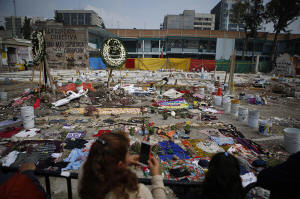Mexico City remembers the 1985 earthquake that changed everything
[September 20, 2025]
By MARÍA VERZA
MEXICO CITY (AP) — Every Sept. 19, residents of Mexico City ask
themselves an unsettling question: “Is the ground shaking?”
On that day 40 years ago, at 7:19 a.m., a 8.1-magnitude earthquake and
its aftershocks left the Mexican capital devastated. Official counts put
the death toll around 12,000, but the real number remains unknown.
The earthquake was a watershed moment for the city. A new culture of
civil defense evolved, better warning systems developed, building codes
changed and, since 2004, there have been annual earthquake drills held
on that day.
Then, on that very same day in 2017, things changed again. Barely two
hours after the annual drill, a 7.1-magnitude temblor began shaking the
ground; its epicenter was so close to the capital that the warning
alarms didn’t even sound.
Nearly 400 died this time and word spread in an instant on social media,
but the destruction showed some lessons still hadn’t been learned, as
many deaths could have been prevented.
Whether the ground shakes or not, Sept. 19 continues to rattle residents
of the capital, because for many there are symbols across the city that
have not been forgotten.
Here are some of them:

Hotel Regis
In 1985's predigital world, one image from the earthquake became seared
into public memory: the sign of the luxurious Hotel Regis crowning the
pile of rubble that the early 20th-century building — a center of
political, artistic and social life – was reduced to.
Today, vendors’ stalls cover the area where its grand pillars once
stood, a site dubbed Solidarity Plaza in honor of the thousands of
average people who came out that day to help.
Surviving babies, collapsed hospital
A red cloud grew before the eyes of the young accounting student,
Enrique Linares, now 62. “I didn’t know what it was,” he recalled.
People were running down the street, doctors with white lab coats
chalked with red dust. Linares looked up at the void where the 12-story
tower with a red light on top should have stood. It was then that he
began to shake and realized that the hospital had collapsed.
The search for survivors went on for days with soldiers controlling
access to the site. After about a week, the effort was rewarded: several
recently born infants were rescued alive from the rubble. They were
dubbed the “miracle babies,” even inspiring a television series about
them.
Screams of the seamstresses
First came the screams from the seamstresses buried under one of the
capital’s collapsed textile plants, recalled Gloria Juandiego, now 65.
Soon after, the screams were from people like her outside the rubble,
who shouted that others were trapped inside. The soldiers did nothing,
she said.
[to top of second column]
|

Clothing, cloth, and flowers are arranged in a memorial that
includes the messages in Spanish: "Our lives matter" and "Our bodies
are not trash," at the site of a textile factory that collapsed in
an earthquake in Mexico City, Sept. 25, 2017. (AP Photo/Rebecca
Blackwell, File)

“The bosses got the equipment out, the raw materials, their safe
boxes, they prioritized that,” she said. They didn’t let them tear
up the salvaged clothing to make tourniquets. Then came the smell
and the image of how “the bodies were tossed into trucks, even as
more and more women came out to demand authorities rescue their
colleagues. In the end, hundreds of seamstresses, normally holed up
working 12-hour days without breaks, died.
“Our submission was buried under the rubble,” a popular sign at the
time read. It was the start of the Sept. 19 seamstress union to
fight for decent working conditions.
And yet, on Sept. 19, 2017, another earthquake trapped textile
workers laboring in similar conditions with heavy machinery in a
poorly constructed building. The only difference was that this time
the victims were immigrants.
‘The Moles’
“We were digging with sardine cans and our hands,” recalled
Francisco Camacho, now 66. In 1985, he was one of the young people
looking for survivors of a collapsed apartment building on
Tlatelolco Plaza, where today a sun dial marks the time of the
earthquake.
A woman organized a chain of volunteers removing buckets full of
debris. Children brought water. Camacho recalled the tenor Plácido
Domingo, who was also helping, saying the volunteers were making
holes and crawling into them “as if they were moles."
And so a volunteer rescue group known as “Los Topos” (The moles) was
born. The organization has grown from 20-some amateurs to a diverse
force of some 1,200 people today. Now, a powerful symbol of Mexican
solidarity, they have traveled to 32 countries to assist at times of
catastrophe. They continue training every Sunday for what could
happen next.
Camacho, now director of “Los Topos,” said pride in his work is
matched by the indelible memory of having to place “many
decomposing” bodies in the capital’s baseball stadium in 1985, an
experience that left the smell of death “impregnating my nose for
months."
All contents © copyright 2025 Associated Press. All rights reserved
 |